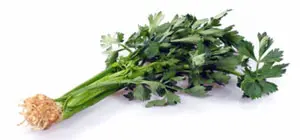 Celery is packed with beneficial nutrients: it contains ascorbic acid (especially abundant in celery leaves), B vitamins, carotenoids, and phytoncides. The root vegetables are primarily composed of potassium salts, and celery also boasts significant amounts of calcium, magnesium, and phosphorus.
Celery is packed with beneficial nutrients: it contains ascorbic acid (especially abundant in celery leaves), B vitamins, carotenoids, and phytoncides. The root vegetables are primarily composed of potassium salts, and celery also boasts significant amounts of calcium, magnesium, and phosphorus.
Like other aromatic vegetables, celery contains essential oils and various flavor compounds that give it a distinct and pleasant taste and aroma. These essential oils have disinfectant and antiseptic properties. Celery and dishes made from it can stimulate appetite and improve digestion.
However, those suffering from stomach or duodenal ulcers are advised to avoid celery, as the essential oils it contains can stimulate the digestive glands. People with nephritis, hepatitis, or gout should also limit their celery intake.
There are several cultivated varieties of celery: leaf, stalk, and root. The leaves of leaf celery are used as a seasoning for soups and fish and meat dishes. Raw stalks of celery are often used in salads, while cooked stalks serve as a side dish for meat and fish. The root celery’s edible tubers can be eaten raw or cooked, stewed, or fried.
You can create delicious salads using the root and stalks of celery. For one salad, wash the root, apples, and carrots, then grate them coarsely, mix together, and dress with mayonnaise and lemon juice. For another option, wash the stalks, sort them, chop them finely, mix with grated cheese, and dress with sour cream or mayonnaise. You can also sauté the washed and finely chopped stalks, add sour cream, sprinkle with grated cheese, and bake in the oven for 30 minutes.
